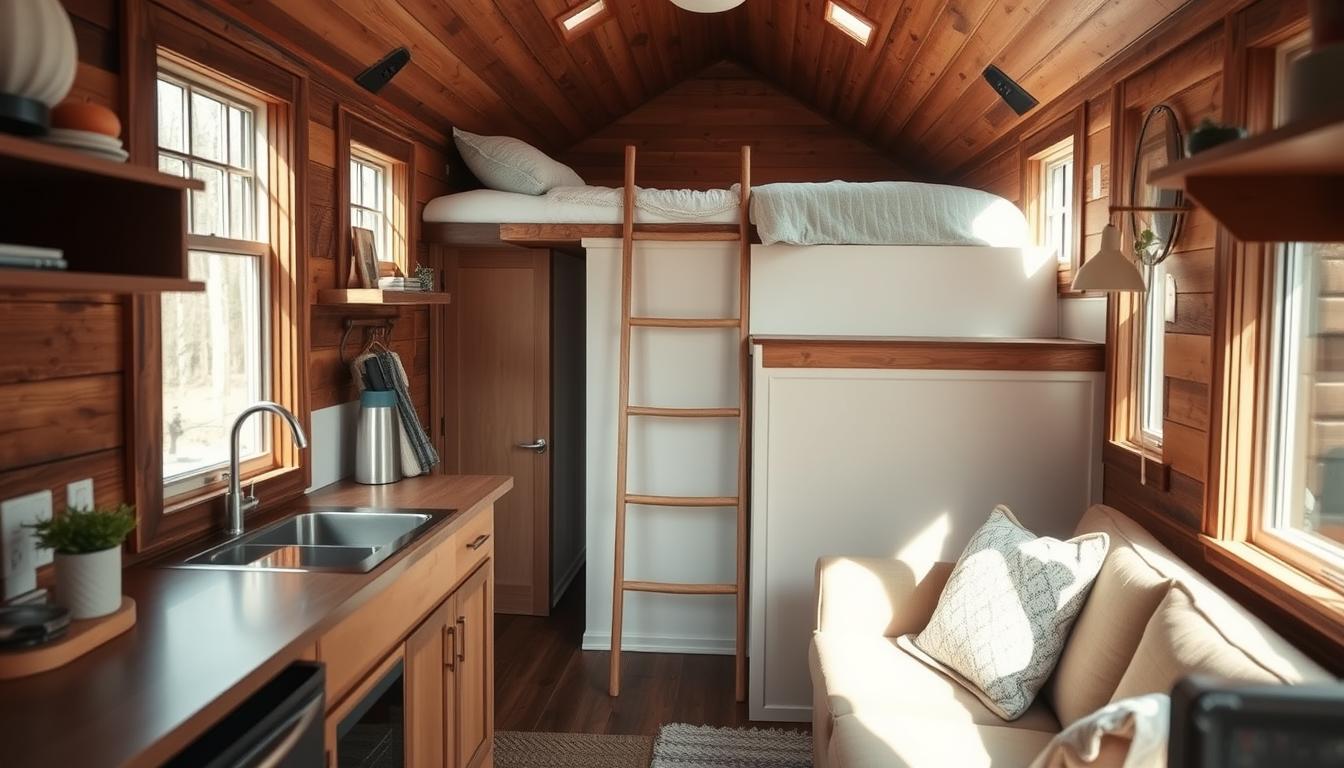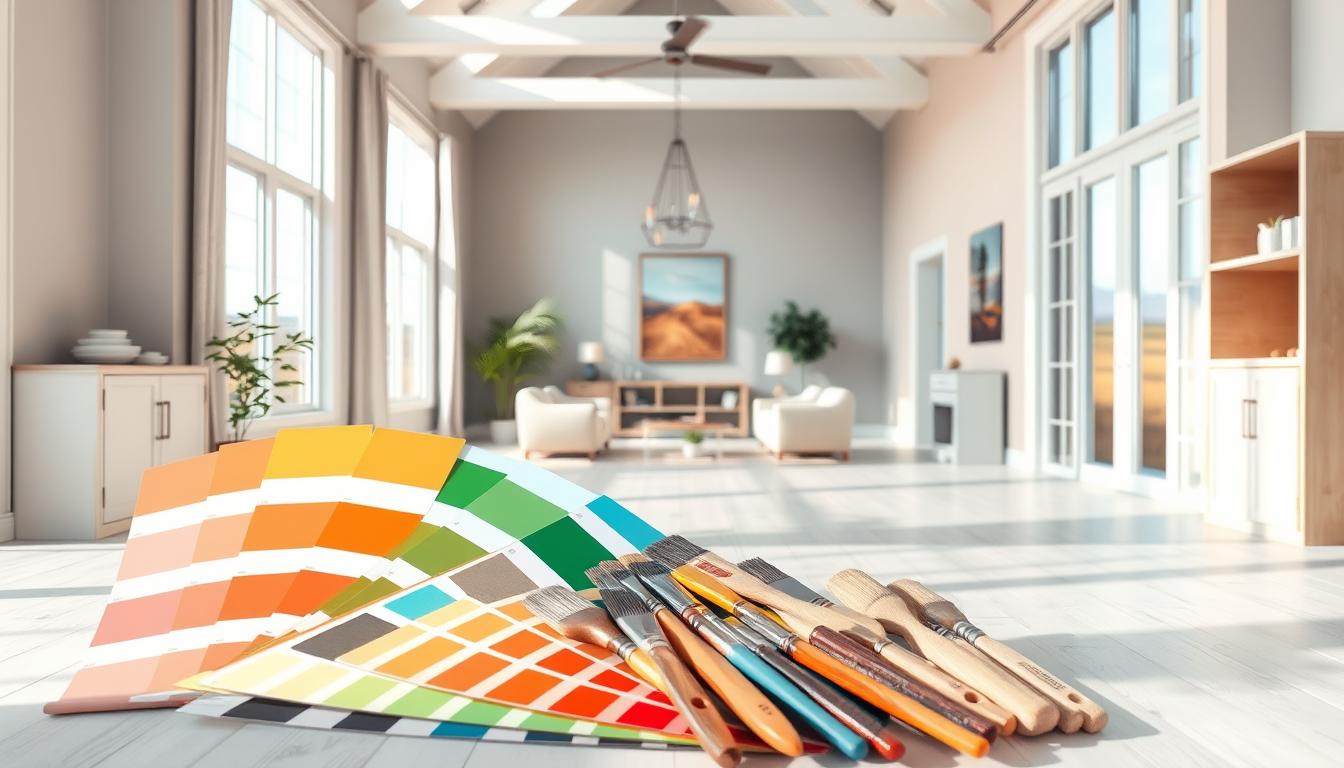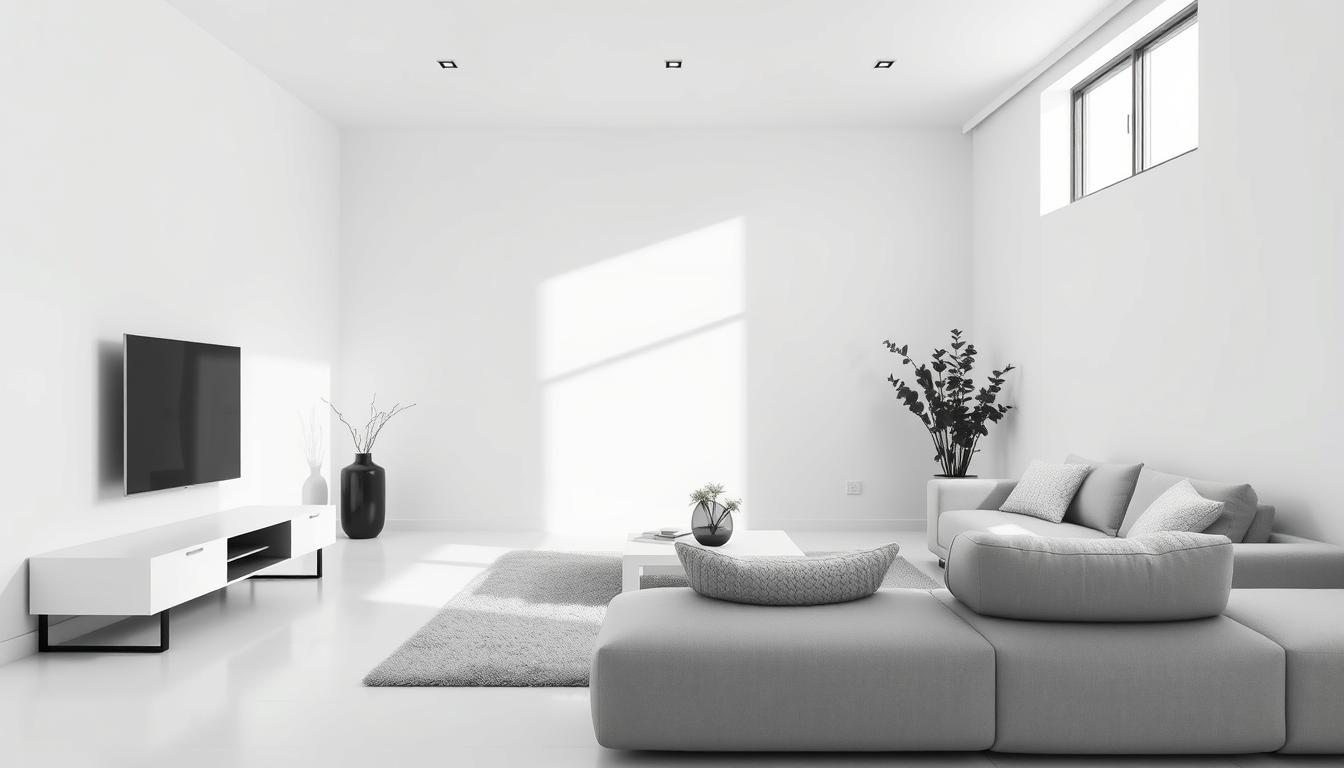Did you know over 10,000 people in the U.S. live in tiny homes? They choose a simpler, more sustainable life. We’re excited to share our top tiny home interior ideas that inspire and help.
We’ll cover design aspects like minimalism and smart tech. You’ll learn to create a cozy, functional, and unique space.
Key Takeaways
- Discover the benefits of minimalism in tiny home design
- Learn how to incorporate smart technology for a more efficient living space
- Explore creative storage solutions for small spaces
- Find inspiration for making your tiny home feel cozy and inviting
- Get tips on how to make the most of your compact living area
Embracing Minimalism for Tiny Homes
Minimalism is more than a design trend; it’s a lifestyle. It turns tiny homes into serene oases. By embracing minimalism, we make our living space both beautiful and practical.
The Benefits of Minimalist Living
Minimalist living has many benefits, mainly for tiny homes. One key advantage is reduced stress. Too much clutter can make us feel anxious and overwhelmed. By keeping only what’s essential, we create a peaceful home.
Another plus is increased efficiency. With fewer things, we spend less time cleaning and searching. This means more free time and a calmer life.
Essential Furnishings for Small Spaces
Choosing the right furniture is key for tiny homes. Multi-functional furniture is a must. It does more than one thing, which means fewer items overall.
Some must-haves include:
- Sofa beds that double as guest beds
- Murphy beds that fold up against the wall when not in use
- Storage ottomans that provide a place to sit and store items
- Nesting tables that can be easily stowed away
By picking furniture made for small spaces, we make our tiny home feel big, welcoming, and useful.
Color Schemes That Open Up Space
In tiny homes, the right colors can make a big difference. A good color scheme can make your home feel bigger and more welcoming.
Bright and Airy Hues
Bright and airy colors are great for tiny homes. Soft whites, light grays, and pale blues reflect light and make spaces feel larger. These colors are not only pretty but also create an airy feel that’s perfect for small areas.
The Power of Neutrals
Neutral colors are versatile and work well in tiny homes. Shades like beige, taupe, and soft cream create a calm atmosphere. Plus, they’re easy to mix with bold colors to add personality without feeling too much.
- Neutrals help in reflecting light.
- They provide a clean and simple backdrop.
- Neutrals are easy to pair with bold colors.
Adding Accents with Bold Colors
Neutrals and bright colors are the base, but bold colors add interest. Use deep blues, rich greens, or vibrant yellows in accessories like throw pillows, rugs, or wall art. This adds personality and depth to your tiny home.
“The right accent color can transform a room, making it feel more dynamic and personalized.” – Interior Design Expert
By mixing bright colors, neutrals, and bold accents, you can create a color scheme that opens up your tiny home. It also shows off your personal style.
Multi-Functional Furniture as a Must-Have
Tiny homes need furniture that does more than one thing. Every piece of furniture is important in tiny house decor. Choosing items that have multiple uses is key. This not only saves space but also makes the home more functional and comfortable.
Sofa Beds and Murphy Beds
Sofa beds and Murphy beds are great for tiny homes. Sofa beds are comfy to sit on during the day and turn into beds at night. Murphy beds fold up against the wall, giving you more floor space when not in use.
Storage Ottomans
Storage ottomans are super useful in tiny homes. They act as extra seating, footrests, and places to store things. By picking ottomans with storage, you can keep your home tidy and still feel cozy.
Extendable Dining Tables
Extendable dining tables are perfect for tiny homes. They can be small when not needed and big when you have guests. This makes them great for small spaces.
| Furniture Piece | Primary Function | Secondary Function |
|---|---|---|
| Sofa Bed | Seating | Bed |
| Murphy Bed | Bed | Wall Space |
| Storage Ottoman | Seating/Footrest | Storage |
| Extendable Dining Table | Dining | Space Saver |
Clever Storage Solutions for Tiny Homes
Storage is key in tiny homes, not just a need. It’s a design challenge. Good storage keeps your space tidy and organized, even with little room.
Utilizing Vertical Space
Using vertical space is smart for tiny homes. Wall-mounted shelves help keep things organized and out of sight. They’re perfect for books, decorations, kitchen tools, and more.
Shelves that reach the ceiling make the most of your space. This keeps floors and surfaces free from clutter.
Under-Bed Storage Ideas
Under-bed storage is a clever idea for tiny homes. Bed risers or storage bins turn the space under your bed into storage. It’s great for seasonal clothes, bedding, and more.
For a tailored solution, look at bed frames with drawers. For more tiny home design tips, see our guide on designing tiny home interiors.
Creative Closet Solutions
Closet space is precious in tiny homes. Use double rods to increase hanging space. Shelf dividers help organize by separating items like clothes and storage bins.
Adding shelves or drawers above or below your closet adds more storage. These ideas help keep your tiny home tidy and organized.
Being creative with storage is essential for a clutter-free tiny home. Use every inch of space wisely.
Natural Light: Maximizing Windows and Skylights
Getting more natural light is key to making tiny homes feel cozy. We look at how to use windows and skylights to make spaces feel bigger.
Choosing the Right Window Treatments
Window treatments greatly affect how much light gets into your tiny home. Sheer curtains or blinds are great because they let you control light while keeping things private.
- Choose light-colored curtains to bounce natural light around.
- Roller shades are simple yet effective.
- Plantation shutters offer style and flexibility.
Strategic Placement of Mirrors
Mirrors can make a room feel bigger by reflecting light. Putting a mirror opposite a window doubles the light in a room.
- Place mirrors to reflect light from windows or skylights.
- Use big mirrors or a few small ones to draw attention.
- Avoid mirrors opposite doors or where they might confuse reflections.
Benefits of Skylights in Tiny Homes
Skylights bring in light from above, making rooms feel bigger and airier. They’re great when you don’t have much wall space.
| Benefits | Description |
|---|---|
| Increased Natural Light | Skylights let in light from above, lighting up the space better. |
| Ventilation | Many skylights open for better airflow, improving home ventilation. |
| Aesthetic Appeal | Skylights add a special architectural touch to tiny homes. |
By using these tips, we can make our tiny homes brighter and more inviting.
Creative Layouts to Enhance Flow
Making your tiny home feel bigger and cozier is key. A smart layout is crucial for a cozy tiny home that meets your needs.
Open-Concept Design Elements
Open-concept design is a hit for tiny homes. It makes the space feel open and free. By removing walls, we use space better. Key elements of open-concept design include:
- Minimalist decor
- Multi-functional furniture
- Strategic use of lighting
These elements help create a smooth flow between areas. This makes the home feel bigger.
Zoning Spaces for Functionality
Open-concept design is great, but zoning is also key for function. Defining areas for different activities keeps the space open yet functional. Effective zoning can be achieved through:
- Furniture arrangement
- Area rugs
- Different lighting schemes
This way, we get a space that’s both functional and comfy.
Using Room Dividers Effectively
Room dividers are perfect for separating areas without losing openness. They range from curtains to shelving units. The benefits of using room dividers include:
| Benefit | Description |
|---|---|
| Flexibility | Room dividers can be easily moved or rearranged as needed. |
| Visual Separation | They provide a clear visual separation between different areas. |
| Aesthetic Appeal | Room dividers can add a decorative element to the space. |
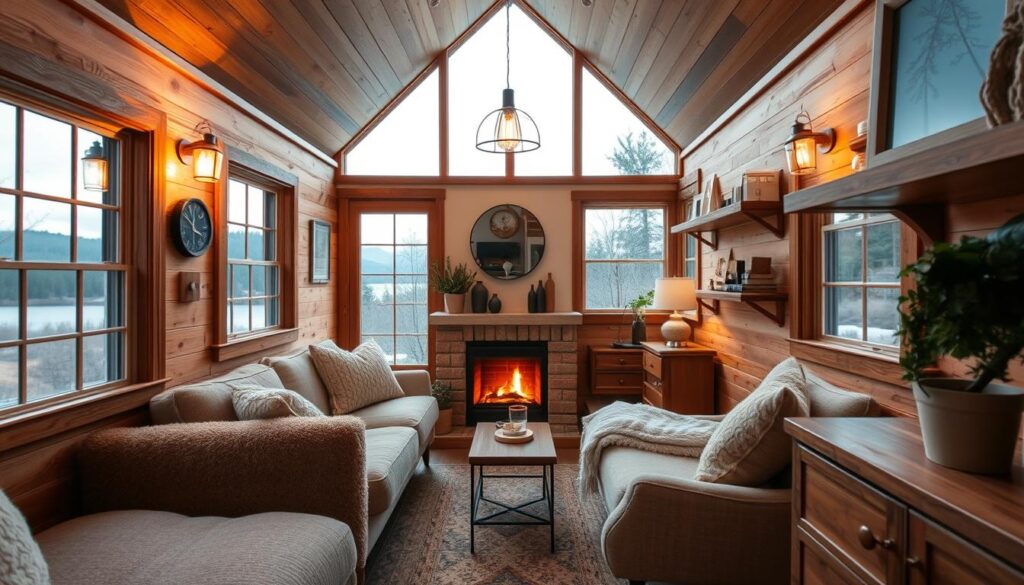
Personal Touches for a Unique Space
Turning a tiny home into a cozy space is more than just picking furniture. It’s about making it show your personality and style.
Incorporating Art and Decor
Art and decor are key to making a tiny home your own. Choosing pieces that speak to you adds depth and character. Think about local art or pieces by new artists for a unique flair.
It’s important to find a balance between looks and function. For example, a decorative storage ottoman can be both useful and stylish.
Family Heirlooms in a Tiny Home
Showing off family heirlooms makes your tiny home special. These items add to the feel of your space. Display them on floating shelves or in a curio cabinet to show them off.
“The way we display our belongings can greatly impact the feel of our home. It’s not just about storage; it’s about showcasing our stories.”
DIY Projects to Enhance Personality
Doing DIY projects is a great way to add your touch to your tiny home. From custom wall art to handmade furniture, you can do a lot. DIY projects let you show your creativity and reuse materials.
- Create a gallery wall with personal photos or art.
- Turn old furniture into unique pieces that show your style.
- Make your own throw pillows that match your colors.
| DIY Project | Materials Needed | Skill Level |
|---|---|---|
| Custom Wall Art | Canvas, Paint, Frames | Beginner |
| Handmade Furniture | Wood, Tools, Finish | Advanced |
| Throw Pillows | Fabric, Thread, Sewing Machine | Intermediate |
Outdoor Living Options for Tiny Homes
Outdoor living options are a game-changer for tiny homes. They provide extra space for relaxation, entertainment, and connecting with nature. Even the smallest outdoor areas can be turned into inviting extensions of our homes.
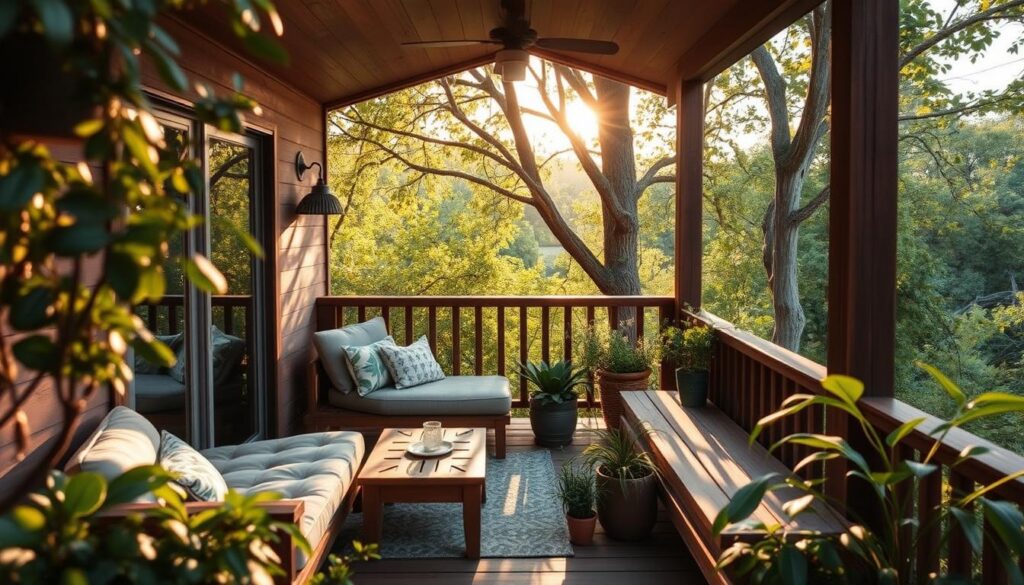
Creating a Cozy Patio or Deck
A cozy patio or deck can make a tiny home feel bigger. Use comfortable outdoor furniture and warm lighting to create a welcoming feel. Adding plants and greenery brings in a natural touch.
- Choose furniture that is both durable and weather-resistant.
- Use outdoor rugs to define the space and add warmth.
- Incorporate decorative elements like throw pillows and planters.
Vertical Gardens and Plant Walls
Vertical gardens and plant walls are great for tiny homes. They add greenery and purify the air. They also create a peaceful atmosphere.
To set up a vertical garden, use a trellis or a modular planting wall. Choose plants like succulents or ivy that do well in vertical spaces.
Outdoor Furniture That Saves Space
Choosing the right outdoor furniture is key for tiny homes. Look for pieces that are both functional and save space. Consider storage ottomans or nested tables.
- Opt for foldable chairs and tables that can be easily stored.
- Use wall-mounted planters and shelves to save floor space.
- Invest in multi-functional furniture pieces that can adapt to different needs.
By using these outdoor living options, tiny home residents can enjoy a more spacious and inviting space. Whether it’s a cozy patio, a vertical garden, or space-saving furniture, there are many ways to enhance a tiny home’s outdoor area.
Sustainable Materials for Eco-Friendly Interiors
Eco-friendly interiors are more than a trend; they’re essential for sustainable living in tiny homes. Choosing the right materials is key as we embrace minimalistic living and small space design.
Recycled and Upcycled Materials
Using recycled and upcycled materials makes our tiny homes more eco-friendly. It reduces waste and adds a unique touch to our spaces.
Some great options include:
- Reclaimed wood for flooring and furniture
- Recycled glass countertops
- Upcycled metal decor
Eco-Friendly Paints and Finishes
The paints and finishes we pick greatly affect our tiny homes’ eco-friendliness. Traditional options often contain harmful VOCs.
Instead, we can choose:
- Low-VOC or VOC-free paints
- Natural wax finishes
- Plant-based stains
The Impact of Sustainable Design
Sustainable design does more than reduce our environmental impact. It also makes our living spaces healthier. Eco-friendly materials improve air quality and reduce chemical exposure, supporting a sustainable lifestyle.
| Material | Eco-Friendly Feature | Benefit |
|---|---|---|
| Reclaimed Wood | Reduces waste | Unique aesthetic |
| Low-VOC Paint | Less harmful chemicals | Improved indoor air quality |
| Bamboo Flooring | Sustainable resource | Durable and renewable |
By adopting sustainable materials and design, we can build tiny homes that are eco-friendly, beautiful, and functional. Sustainable living is not just a choice; it’s a necessity for a healthier planet.
Smart Technology in Tiny Home Interiors
Smart technology is key in making our tiny homes better. It helps us use space well, saves energy, and makes our homes cozy.
Streamlining Space with Automation
Home automation changes the game for tiny homes. It lets us control lights, temperature, and security from afar. This tech helps us use our space-saving furniture better.
Intelligent Storage Solutions
Smart storage keeps our stuff organized and hidden. It helps us keep our tiny homes neat and tidy.
Energy Efficiency through Smart Appliances
Choosing energy-efficient appliances is important. They help us use less energy and live more sustainably.
Smart technology helps us balance function, comfort, and green living in tiny homes. It makes our space-saving furniture and layouts work best.

